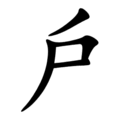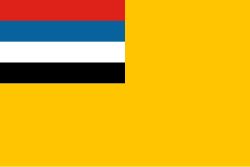Differences between shinjitai and simplified characters in the Japanese and Chinese languages exist. The old and new forms of the kyōiku kanji and their...
12 KB (2,143 words) - 06:40, 22 May 2025
in shinjitai are also found in simplified Chinese characters, but shinjitai is generally not as extensive in the scope of its modification. Shinjitai were...
23 KB (2,219 words) - 00:59, 7 July 2025
Chinese Character Simplification Scheme Second round of simplified Chinese characters Ryakuji Shinjitai Differences between Shinjitai and Simplified characters...
60 KB (6,650 words) - 15:07, 4 August 2025
non-Chinese languages written using Chinese characters, Japanese kanji include many simplified characters known as shinjitai standardized after World War II, sometimes...
25 KB (2,345 words) - 18:35, 21 July 2025
section § Differences in simplification between China and Japan above. The following kyōiku kanji are characters of Group 1 (not simplified in either...
135 KB (5,126 words) - 21:57, 13 June 2025
hanja in Korea, and chữ Hán in Vietnam. For example, the traditional character 廣; 'wide', 'broad' has the simplified form 广 and the shinjitai kanji form 広...
72 KB (9,195 words) - 08:24, 17 July 2025
Hyōgai kanji (section Traditional and simplified forms)
the same simplification processes as in the development of shinjitai. The newspaper The Asahi Shimbun developed its own simplified characters, known as...
8 KB (936 words) - 23:45, 4 May 2025
Kanji (redirect from Chinese characters in Japan)
Japan made its own efforts to simplify the characters, now known as shinjitai, by a process similar to China's simplification efforts, with the intention...
91 KB (9,193 words) - 21:31, 29 June 2025
first round in 1969 included 502 simplified characters, and the second round in 1974 included 2287 simplified characters—including 49 that differed from...
121 KB (14,155 words) - 23:34, 31 July 2025
Han unification (redirect from Giga Character Set)
did make it into Unicode as distinct code points. Sixty-two Shinjitai "simplified" characters with distinct code points in Japan got merged with their Kyūjitai...
60 KB (6,329 words) - 17:25, 27 June 2025
Japanese writing system (redirect from Japanese characters)
part of words. Hiragana and katakana characters also originally derive from Chinese characters, but they have been simplified and modified to such an extent...
39 KB (4,456 words) - 00:47, 20 June 2025
Ming typefaces (category Articles containing simplified Chinese-language text)
most of the Kangxi style characters were called kyūjitai (old style), while the reformed characters were called shinjitai, causing newer dictionaries...
11 KB (1,168 words) - 06:38, 19 May 2025
Radical 113 (category Simplified Chinese radicals)
in shinjitai, and the difference between 礻 and ⺬ is treated as the difference between the new and old forms (e.g. 禪→禅). However, this simplification applies...
11 KB (804 words) - 19:02, 15 May 2025
entrances of schools, government offices and police stations. Calligraphy – in simplified or traditional characters – is invariably written vertically. Additionally...
31 KB (3,262 words) - 20:51, 4 May 2025
Sinicization (section Mongolic and Turkic peoples)
values, pride in being the country's citizen, respect and acceptance towards cultural differences among citizens of China.[citation needed] Critics argue...
86 KB (8,733 words) - 11:16, 25 July 2025
Radical 63 (category Simplified Chinese radicals)
Chinese Character Components predominantly adopted by Simplified Chinese dictionaries published in mainland China. Since the difference between 户 and 戶 is...
8 KB (489 words) - 05:22, 3 August 2024
Homograph (redirect from Heterography and homography)
to merging two different characters into the same glyph during script reform (See Simplified Chinese characters and Shinjitai). Some examples of homographs...
11 KB (877 words) - 13:28, 25 June 2025
modern, simplified characters are called new character forms (新字体, shinjitai). A few examples follow, with the old characters on the left and the new...
64 KB (6,256 words) - 02:59, 16 July 2025
Pronunciations for some elements differ between mainland China and Taiwan, as described in the article. Simplified characters and mainland Chinese pronunciations...
41 KB (3,216 words) - 17:12, 20 June 2025
National Characters, Chinese: 國字標準字體) Traditional Chinese (Hong Kong, using education standard: List of Graphemes of Commonly-Used Chinese Characters, Chinese:...
64 KB (1,174 words) - 01:34, 31 July 2025
Mukden incident (category Articles containing simplified Chinese-language text)
Manchurian incident. In Japanese, "Manchurian incident" (Kyūjitai: 滿洲事變, Shinjitai: 満州事変, Manshū-jihen) usually refers to the entire sequence of events (including...
36 KB (4,161 words) - 19:59, 25 July 2025
Qi (section Characters)
kyūjitai ("old character form") kanji 気 is the Japanese shinjitai ("new character form") kanji 气 is the simplified Chinese character. In addition, qì...
46 KB (5,295 words) - 07:55, 2 August 2025
characters for the endonyms above are simplified Chinese characters and will only appear in the table above if they differ from the kanji shinjitai (the...
58 KB (1,730 words) - 18:40, 19 March 2025
explicitly mark voicing for hiragana and katakana. Japan officially adopted simplified shinjitai (新字体, "new character forms") in 1946 as part of a round...
66 KB (4,886 words) - 06:06, 17 July 2025
JIS X 0208 (category Articles containing simplified Chinese-language text)
Dictionary were changed into variants, and especially more simplified forms (e.g. ryakuji and extended shinjitai). For example, a couple of code points...
152 KB (13,281 words) - 03:48, 20 July 2025
Japanese yen (category Articles containing simplified Chinese-language text)
same word, which was given the shinjitai form 円 in reforms at the end of World War II.[citation needed] The spelling and pronunciation "yen" is standard...
89 KB (7,506 words) - 22:42, 19 July 2025
Shina (word) (category Articles containing simplified Chinese-language text)
use the same Chinese characters (with Japanese shinjitai simplifications) used officially in both the People's Republic of China and the Republic of China...
24 KB (2,576 words) - 03:57, 26 July 2025
Manchukuo (category States and territories established in 1932)
the same Han characters sharing the same meaning in both Japanese and Chinese, allowing for the use of the simplified and variant characters that exist...
145 KB (17,082 words) - 17:07, 30 July 2025
Classic of Poetry (category Articles containing simplified Chinese-language text)
share the same, identical words (or characters) to a large degree, as opposed to confining the parallelism between lines to using grammatical category...
46 KB (4,621 words) - 23:43, 3 August 2025
Novel (section Cervantes and the modern novel)
countries, like China, Korea, Vietnam and Japan, use the word 小說 (variant Traditional Chinese and Shinjitai: 小説; Simplified Chinese: 小说; Hangeul: 소설; Pinyin:...
103 KB (12,596 words) - 00:27, 26 July 2025















